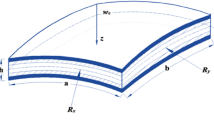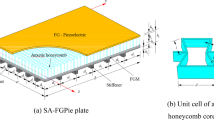Abstract
A quantitative estimate of the left ventricular muscle'sin vivo elasticity, as given by the Young's modulusE of the left ventricular muscle medium characterises resistance to left ventricular filling during diastole, contractile effort of the left ventricle, at the instant of opening of the aortic valve and myocardial diseases, such as myocardiopathy. This paper aims to provide the pertinent analysis (and in particular its, results in the form of nomograms) that can be employed, in conjunction with closed-chested data-acquisition methods, to obtainin vivo values of the effective modulus of left ventricular muscle medium. A vibrational analysis of the left-ventricle chamber model is developed to obtain the values of the primary freqeencies of vibration in terms of the dimensions of the model and the modulusE. On obtaining the values of the model dimensions (by matching the model volume and mass with the left-ventricle dimensions obtained from cineangiocardiography), and of the frequency associated with the maximum energy content of the pertinent heart sound, we can employ the analysis to determine the instantaneous value of the modulusE of the left ventricle. Our paper hence presents data acquisition for developing the model, analysis of the left ventricular model to yield ready-for-use nomograms givingE for prescribed heart sound frequency and the procedure for clinical use of the nomograms and clinical application of the model.
Sommaire
L'évaluation quantitative de l'élasticitéin vivo du muscle ventriculaire donné par le module de Young E pour le milieu musculaire du ventricule gauche, caractérise, 1e-la résistance au remplissage du ventricule gauche pendant la diastole, 2e-l'effort contractile du VG à l'instant de l'ouverture de la valve aortique et 3e-la condition du coeur dans les maladies du myocarde telles que la myocardiopathie. L'article a pour but de fournir l'analyse pertinente (et en particulier ses résultats sous la forme de nomogrammes) pouvant être employée en conjonction, avec les méthodes de recueil de données par thorax fermé, pour obtenir des valeursin vivo du module effectif du muscle ventriculaire, gauche moyen. On développe une analyse vibratiore d'un modèle de la cavité VG afin d'obtenir les fréquences primaires de vibration en termes 1e des dimensions du modèle et 2e du module E. L'obtention des dimensions du modèle (en appareillant le volume et la masse du modèle avec les dimensions VG obtenues par cinéangiocardiographie), et de la fréquence associée avec la teneur d'énergie maximum du son cardiaque pertinent, permet d'employer cette analyse pour déterminer la valeur instantanée du module E du ventricule gauche. Notre atticle présent donc 1e l'acquisition des données pour le développement du modèle, 2e l'analyse du modèle ventriculaire gauche pour fournir des nomogrammes prêts à l'usage donnant la valeur de E de la fréquence d'un son cardiaque indiqué, 3e le procédé d'utilisation clinique des nomogrammes et l'application clinique du modèle.
Zusammenfassung
Die quantitative Bestimmung der Elastizität des linken Ventrilekmuskelsin vivo nach dem Elastizitätsmodul E des linken Ventrikelmuskelmediums gibt an: (i) Widerstand gegen die linke Ventrikelfüllung während des Diastole, (ii) Kraft zum Zusammenziehen des linken Ventrikels bei Öffnen der Aortenklappe und (iii) Zustand des Herzens bei Erkrankungen des Myocards wie z.B. Myocardipathie. Der Aufsatz ist ein Versuch, die entsprechende Analyse zu liefern (insbesondere ihre Ergebnisse in Form von Nomogrammen), die in Verbindung mit der Datenerfassung am geschlossenen Brustkorb dazu verwandt werden können, um In-Vivo-Werte des wirksamen Moduls für das Muskelmedium des linken Ventrikels zu erhalten. Eine Vibrationsanalyse des linken Ventrikelkammermodells wurde entwickelt, um die Werte für die primären, Schwingungsfequenzen im Verhältnis zu (i) der Abmessung des Modells und (ii) dem Elastizitätsmodul E zu erhalten. Bei Erhalt der Werte für die Modellabmessungen (durch Anpassung des Modellvolumens und der Masse an die linken Ventrikelabmessugen aus der Cineangiokardiografie) und der Frequenz, die mit dem maximalen Kräftegehalt des entsprechenden Herztons verbunden ist, können wir die Analyse dazu verwenden, den momentanen Wert des Elastizitätsmoduls E des linken Ventrikels zu bestimmen. Unser Aufsatz stellt daher (i) die Datenerfassung zum Entwickeln des Modells dar, (ii) eine Analyse des linken Ventrikelmodells zur Aufstellung von einsatzfähigen Nomogrammen, die den Wert E für eine vorgeschriebene Herztonfrequenz, angeben, (iii) ein Verfahren für den klinischen Gebrauch der Normogramme und die klinische Anwendung des Modells.
Similar content being viewed by others
References
Adolph, R. J., Stephens, J. F. andTanaka, K. (1970) The clinical value of frequency analysis of the first heart sound in myocardial infarction,Circulation 41, 1003.
Advani, S. H. andLee, Y. C. (1970) Free vibrations of fluid-filled spherical shells.J Sound Vib. 12, 61.
Bunnel, I. L., Ikkos, D., Rundhe, U. G. andSwan, H. J. C. (1961) Left heart volumes in coarctation of aorta.Am. Heart J. 61, 165.
Dodge, H. T., Sandler, H., Ballew, D. W. andLord, J. D. (1960) The use of biplane angiocardiography for measurement of left ventricular volume in man.Am. Heart J. 60, 762.
Ghista, D. N. andVayo, W. (1969) The time varying elastic properties of the left ventricle.Bull. Math. Biophys.31.
Ghista, D. N. andSandler, H. (1970) Indirect determination of human left ventricular performance.J. Assoc. Adv. Med. Instrum.
Sandler, H. andDodge, H. T. (1968) The use of single plane angiocardiograms for the calculation of left ventricular volume in man.Am. Heart J. 75, 325.
Author information
Authors and Affiliations
Rights and permissions
About this article
Cite this article
Ghista, D.N., Nagabhushana Rao, B. & Advani, S.H. In vivo elastic modulus of the left ventricle: Its determination by means of a left ventricular vibrational model and its physiological significance and clinical utility. Med. & biol. Engng. 13, 162–170 (1975). https://doi.org/10.1007/BF02477723
Received:
Accepted:
Issue Date:
DOI: https://doi.org/10.1007/BF02477723




